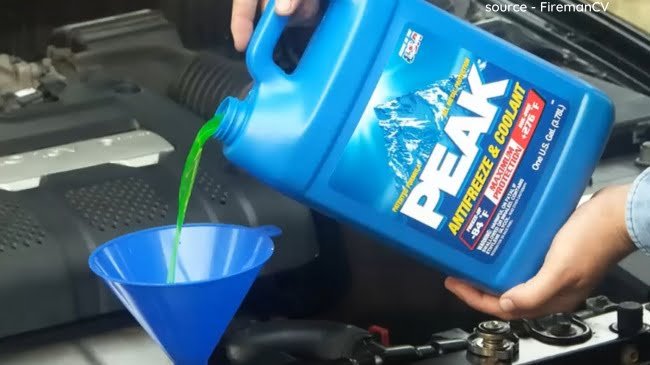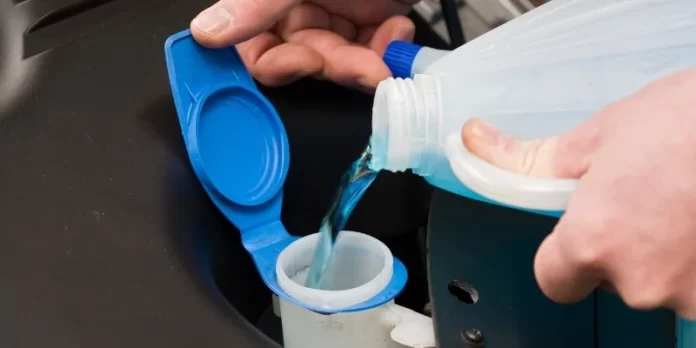It’s vital that your car has enough coolant and it’s an important check when doing vehicle maintenance.
The antifreeze circulates with the help of engine pumps. Therefore, is it necessary for the engine to be running before adding your antifreeze?
The answer is no. never add antifreeze with your engine running. First, turn off the engine and ensure it has sufficient time to cool before you add the antifreeze.
It’s a necessary precaution because opening the car radiator cap with the engine running will cause the steam and coolant to spray out which can severely burn you.
The running motor heats the whole engine bay and the fill cap is extremely hot to touch. Wait until the engine cools then add antifreeze.
Most importantly it’s difficult to know the level of the antifreeze or coolant with the engine running. You can add too little or too much coolant which shouldn’t be the case.
How long should you turn off the engine before you add antifreeze?
At least 30 minutes is adequate time. Add antifreeze 30 minutes after turning off your car engine or wait until your radiator is no longer hot when you touch it.
After you add antifreeze, start the car and check for leaks. If you see none, proceed and drive the car a short distance to ensure the new coolant starts circulating through the system. Go ahead and recheck your radiator level and add more coolant if necessary.
You should only add the coolant when your engine is cold and the temperatures are 30-50 degrees Celsius. At this point, chances of the engine cracking are minimal and your coolant will not expand much.
What are the consequences of adding antifreeze to a hot car engine?
Adding antifreeze to a hot car engine causes serious damage. If the coolant hits the hot engine, it can crack it and cause corrosion. Cracks in your car engine lead to leaks which in return makes your engine overheat and seize up eventually.
Is it safe to add antifreeze to a warm engine?
No, it’s not. Don’t add coolant to a warm engine as the hot metal will compress abruptly causing cracks in the engine block.
Also, the heat makes the coolant expand. Therefore, adding more will make the coolant overflow. Let the engine cool down before you open the radiator cap to add coolant.
How do I know if the car needs antifreeze?
It’s advisable that you check the coolant level once a month and more times if the temperature gauge keeps going up. If you routinely add antifreeze, then you may have a leak that needs fixing.
There are common symptoms that help you know if the car needs coolant.
Engine is overheating
If the car is running hot or the temperature gauge on your dashboard reads an abnormal value, then it’s time to pull over. Check the under your hood for signs of leaks like wetness or pooled fluid beneath the vehicle.
Steam coming from the hood
It’s a sign that your cooling system is in trouble and needs a quick remedy to arrest the situation before the entire cooling system is compromised. Failing to take quick action results in serious engine damage.
Reduced engine performance
A low coolant level reduces engine performance and it keeps on seizing up.

Is it okay to add antifreeze to the reservoir when the car engine is hot?
No. Never add antifreeze to a hot engine as you risk getting burnt by the steam coming from that reservoir or the hot coolant.
Remember, the cooling system is highly pressurized and if you remove the radiator cap to add antifreeze when the engine is hot can cause severe burns. Let the engine cool down first then open your car radiator cap and add the coolant.
Your engine should be cold before adding the coolant. It’s a precaution to avoid potential injuries from the hot engine. Besides, it’s easier to know the coolant level when the engine is off.
Most vehicles made after 2005 have reservoirs near the front part of the engine bay. The radiator is found at the back of the car engine bay. If your car has a radiator, then add the antifreeze to the radiator itself.
On the other hand, if you have a reservoir then add the antifreeze to the reservoir. However, never add the antifreeze to the engine directly.
How do I add antifreeze to my vehicle?
It’s easy to top up your coolant reservoir. Start by choosing the right antifreeze or coolant meant for the vehicle.
Generally, you can add a new coolant onto the old one which makes topping it up easier if the level is low. Never substitute the coolant with water, it’s only advised in emergencies.
Depending on your coolant type, the mix is recommended like a 50/50 mixture with distilled water.
- Remove the cap to access the coolant reservoir.
- Use a funnel and note the antifreeze in the bottle before you pour it into the reservoir. Some bottles have clear strips that allow you to know the amount of coolant you poured to avoid overfilling.
- After pouring, replace the cap and ensure it’s tight to ensure the cooling system has pressurization. Failing to tighten the cap compromises the performance of the cooling system.
Can low coolant give my car rough idle?
Yes. Your car can have roughly idle if the coolant is low. Remember, when the engine is low on antifreeze, it can’t properly lubricate moving parts.
It’s a problem that can increase heat and friction resulting in engine damage making it run roughly.
If you realize that you have a low coolant level, go ahead ad add more antifreeze soonest. It’s not recommended that you drive around with a low coolant level. For instance, if the car starts overheating, your journey is compromised.
Pull over and check your coolant level. If the level is low, add some coolant to ensure efficient lubrication of the moving parts and help you continue your drive.
However, the engine can be seriously damaged if it overheats again because you didn’t add coolant.
What does it mean if the coolant level is low but there are no leaks?
A few reasons come to mind if you have a low coolant level but you don’t see leaks. First, you have an evaporation problem.
Remember the coolant has water that over time evaporates. It’s a common thing if you regularly drive in hot weather. You need to regularly add antifreeze to maintain optimum coolant level.
Secondly, you have a faulty radiator cap. The radiator cap is meant to prevent the coolant from leaking by keeping it in the system.
Also, if your pressure relief valve is faulty, the coolant escapes. If you suspect that your radiator cap is faulty, replace it early.
Thirdly, you may be having a small leak in the cooling system. It’s difficult to see this leak because it happens at the connection or joints in the system. A leak is not visible until it pours on the ground of your coolant level drops.
Is it a must to always have a full coolant reservoir?
Yes, it is highly recommended as it ensures your system has enough coolant. Add more antifreeze to the full line, but don’t overfill your reservoir as it can cause problems with your cooling system.
Bottomline
Only add coolant when your engine is cold to prevent serious burns. The hot coolant and steam also make it difficult to see your antifreeze level when your engine is on.
Never add coolant directly to the engine, but add it to the radiator or the reservoir. After adding antifreeze, start the car and let the engine run for a few minutes to circulate the coolant.
Besides, it helps you discover potential leaks in your system. Water can only be added in extreme emergencies when the engine is overheating. Water lacks the corrosion-inhibition and antifreeze properties found in coolants.



